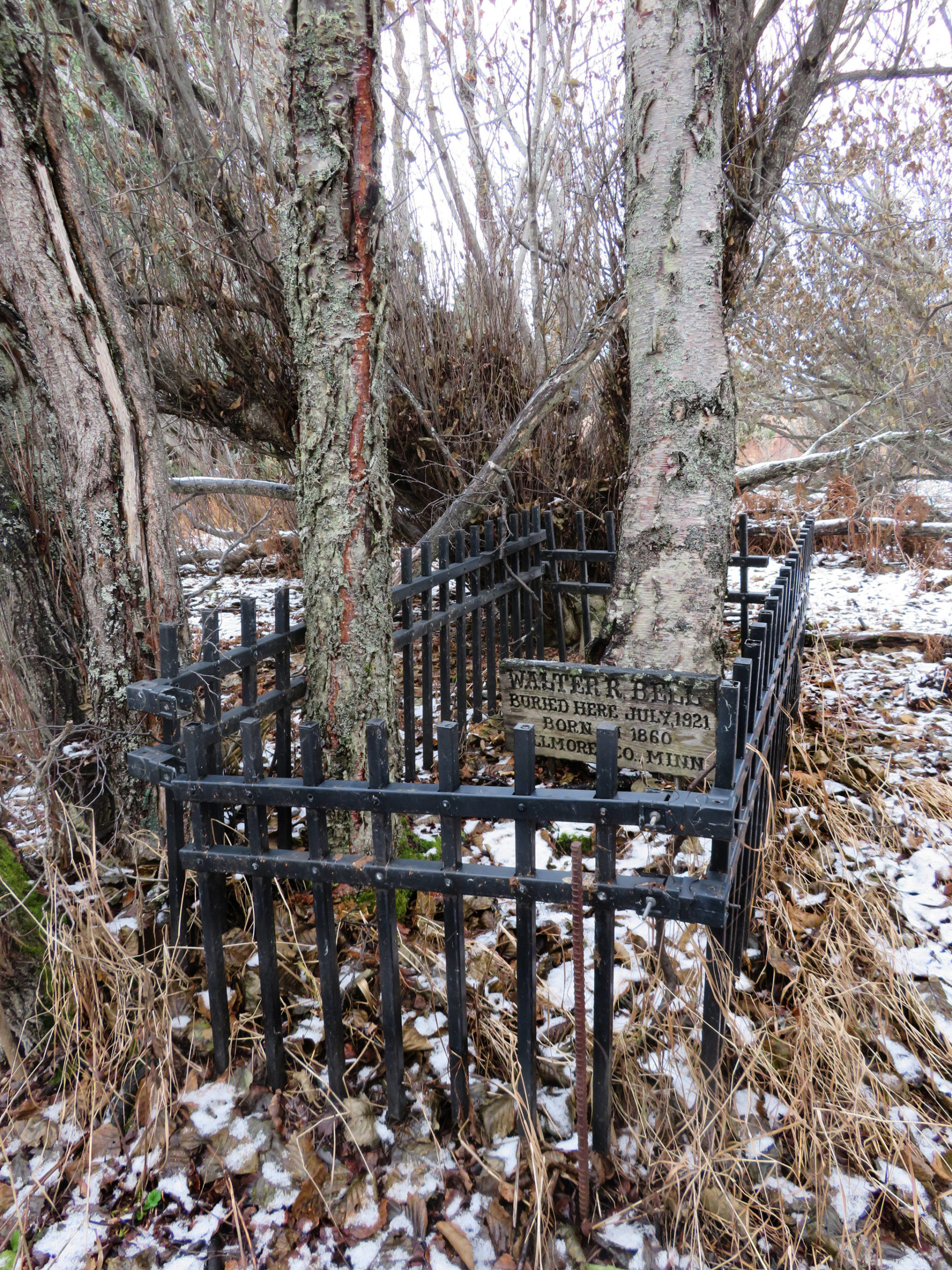Last summer, my partner, Yvonne, asked me whether I’d ever seen the grave near the Reber Trail in Homer. I’d been up and down that trail many times but never seen a grave. “How far off the trail is it?” I asked. “Not far,” she replied. “Maybe 50 feet. Easy to miss, though.”
Because Reber Trail connects the west end of the city’s Fairview Avenue to West Hill Road, near where I live, I continued traveling that route. Then in mid-November, Yvonne and I were descending the trail when she detoured to show me the grave.
It lay atop a short, grassy scramble just above a switchback: a lichen-speckled, rectangular redwood marker, surrounded by a rectangle of hip-high metal fencing. Also inside the fence were two mature birch trees, one near the head and one near the foot of the grave.
The marker read: “Walter R. Bell. Buried here July 1921. Born in 1860, Fillmore Co., Minn.”
The sight prompted several questions. Why had someone been buried on this spot? Why was there a city-maintained walking trail next to his grave? Since he had died 98 years earlier, who had erected this fairly modern marker? And most importantly, who was Walter R. Bell, and what had he been doing in Homer in the first place?
Over the next two weeks, I consulted census records, a city parks employee, a local historian and an official from the Pratt Museum. Here, in a nutshell, is what I learned:
The grave of Walter R. Bell is one of three burial properties overseen by the City of Homer. (The other two are regular cemeteries.) His time in Homer was brief — only five years — but impactful, according to his daughter, Dene, who arranged for her father’s burial site to become city property.
According to U.S. and Minnesota census records, Walter, at age 20 in 1880, was living with his parents in Newburg, Fillmore County, and working as a farm laborer. He was still there in 1885 but moved shortly afterward. Near White Sulphur Springs, Montana, he worked for cattle companies and, in 1891, married Matilda Sellers. In about 1899, he and his wife and two children, Willard and Dene, moved to Montana’s Stillwater Valley and began sheep ranching. There, their third child, John, was born in about 1903.
Sometime after that, I suspect, things began to unravel, although Bell’s daughter did not elaborate, and census records provided only enough data to prompt speculation.
By 1910, Willard had died. Walter and Matilda owned their own home and were still ranching in Montana, still raising 16-year-old Dene and 7-year-old John. Also in their household was Matilda’s 62-year-old mother, a 32-year-old hired hand and a 16-year-old servant boy.
Five years later, according to Dene, her father abandoned the family and sold the ranch. “I never saw him again,” she wrote in 1966.
In the fall of 1916, Bell arrived in Homer aboard “an old condemned Great Lakes steamer” he had chartered from Seattle. He brought with him a mare and a gray stallion, some cattle, pigs and chickens, and “enough ranch machinery to establish (a) going ranch.”
Why Bell chose Homer is unclear — he may have sojourned briefly in Seldovia — but on the lower hillside above what is now downtown Homer he staked out a piece of ground and settled in with his menagerie. He erected ranch buildings and a small house and built a garden in his front yard. His homestead patent was issued on Oct. 18, 1919.
According to his daughter, he was one of Homer’s first ranchers and homesteaders, which seems likely since the 1920 census of the area counted only 46 residents. She said that in 1919 he helped establish the first Homer school, near Miller’s Landing, and joined its first board of directors. He also sold beef locally and across the bay. In fact, the only two photographs of Bell I have seen were taken in Seldovia.
In 1921, 61-year-old Walter Bell attended a Fourth of July celebration on the Homer Spit. A day or so later, “a neighbor found him lying dead on his doorstep,” wrote his daughter. “They buried him there in his garden.” All of the ranch buildings were burned in a grass fire sometime after his death, but the Sitka roses he had planted in his front yard kept blooming for decades.
In September 1970, Dene — who erected the wooden marker on her father’s grave, finished proving up on her father’s nearly 90-acre homestead and held onto the land for many decades — completed an official donation of 2.75 acres of the old homestead to the city as the W.R. Bell Public Park. The trail angling through the park is named for Dene and her husband, Edward A. Reber.
On Feb. 18, 1988, the Homer News published a letter that Dene, from her home in California, had written to the editor. She briefly described her father’s time in Homer, adding: “Enclosed find a check for $12 for a subscription to your paper until April 1. I am Walter Bell’s daughter and don’t expect to be here much beyond that time. … I doubt if there is anyone there who remembers Walter Bell, or me, although I was in Homer two or three times. Thank you for reading this and for sending the paper. It is all so long, long ago. I will be 94 years old this April 10, and that is surely too long to live!”
Dene Bell Reber lived another year and a half, dying on Oct. 16, 1989, and leaving behind a more lasting legacy, perhaps, than had her father’s brief presence in this seaside community.
• By Clark Fair, For the Peninsula Clarion

